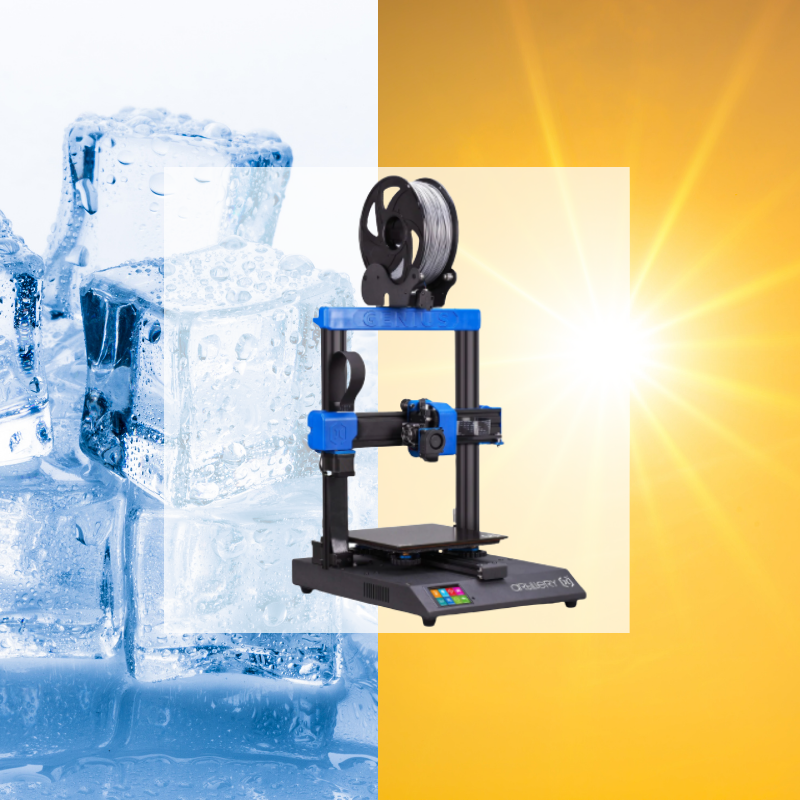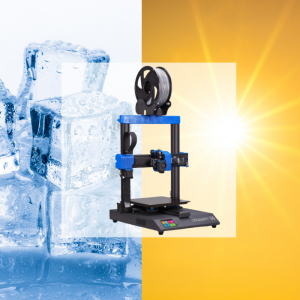
Installing a 3D printing device does not mean you will be achieving the perfect printing quality right away. The printing quality of the machines depends on different factors. The temperature is obviously, one of the main factors that impact the printing quality significantly. That is why most people wonder whether they should complete their 3D printing procedure in a hot or a cold room. In this article, we will try to address this question so that you can have a better idea about 3D Printing.
If you support your 3D printer in different conditions, you can continue printing in both hot or cold rooms. Appropriate conditions mean you need to maintain the printing temperature and make sure you are using the right kind of printing materials. The best way to ensure that is to keep your machine inside of an enclosure. If you are using ABS filament in a 3D printing machine in a cold room, you will face massive warping issues. However, the PLA filament can pull through the printing procedure without facing any problems.
Table of Contents
Can You 3D Print In Cold Weather?
Temperature is one of the more essential factors during the 3D printing procedure. It would be almost impossible to continue the printing procedure in a cold environment, as you would not maintain the printing temperature properly. That is why you need to keep on monitoring the temperature of the printing environment while working.
Different kinds of print materials need various optimum temperatures to perform appropriately. If You use ABS filaments for Printing, you should try to keep the entire printing region more or less hot to avoid warping.
Contrarily, if you choose PLA filaments for Printing, you can continue the printing procedure at a relatively colder temperature. Most of us start to face problems with PLA filament if the temperature plunges below 15 degrees centigrade.
The one thing you need to control during the printing procedure is the fluctuation of temperature. Considerable temperature changes can create significant problems in Printing. Warping is one of the issues that occur if the print layers get cooled down too quickly. It is then you start to see the corners of your print curl away from the printing bed. It hampers the print quality. As the bed adhesions get reduced, the half-done Prints can get knocked over from the Printing also.
If you control the fluctuations of temperature, 3D Printing in colder temperatures is not that impossible. However, completing the printing procedure ideally can be difficult. There might be some temperature points where it is significantly problematic to continue the printing procedure successfully.
Can You 3D Print In A Hot Room?
You can print anything efficiently in a hot environment. However, there are certain limitations regarding the temperature that you need to follow. To ensure that your 3D printer gets an improved working environment, you need to install cooling fans. If you live in a place where the surroundings are hot naturally, you can also use an air conditioner while 3D Printing.
It is relatively easier to work with PLA printing elements in a hot environment. The reason is, this element is not as sensitive to temperature fluctuations as the ABS filament. It would help if you made sure that the operating temperature of the machine is not excessively hot. If you cannot control the operating temperature, it can mess up the prints significantly.
The level of problems will depend on the printing material. The printing materials like PLA, which have a lower glass transition temperature, do not perform well in hot temperatures. However, if you have installed efficient cooling fans, you can continue the printing procedure successfully. However, it would not be as easy a procedure as you may imagine.
Regardless of the kind of filament you use, make sure that the room’s overall temperature, where you are completing the printing procedure, does not cross 50 degrees Celsius. If the temperature goes beyond this point, the prints can get spoilt. Also, your 3D printing machine can get overheated, resulting in various other complications.
Does Room Temperature Impact 3D printing?
Irrespective of the environment, you should try to ensure temperature stability while working with your 3D printing machine. So yes, the room temperature does play a massive role in the performance of your 3D printing machine. The room temperature also impacts the longevity and the efficiency of your machine in the long run.
You need to understand that no printer likes to perform in any extreme environment, be it too hot or cold. High temperature can lead to the formation of the printed material and the parts of the 3D printing machine. On the other hand, the freezing temperature’s can cause warping between the layers of the printed element.
What Is The Best Temperature For 3D Printing?
Generally speaking, it is hard to pinpoint the exact temperature that is best for 3D Printing. Instead of focusing on the precise temperature, you should keep a range of temperature in your mind while using the 3D printing machines. Temperature stability is an essential thing that you need to keep in mind. So, to get high-quality print output, you should maintain a room temperature between 17 to 20 degrees centigrade.
Do I Need To Use A Heater In The Printer Enclosure?
If you are using the printer in a cold environment, it is better to use a heater. It will help you keep the printing area’s overall temperature stable and suitable for the printer to perform seamlessly. Otherwise, the temperature may fluctuate, creating issues in the performance of the printer. So, try to use the heater to ensure that the work area does not get too cold. Excessively low temperatures can create issues for the nozzle and the filament of your 3D printer.
All in all, monitoring the temperature is one of the main steps to ensure a smooth printing experience. If you monitor the temperature range and follow the printing procedures closely, you will get very satisfactory results.

